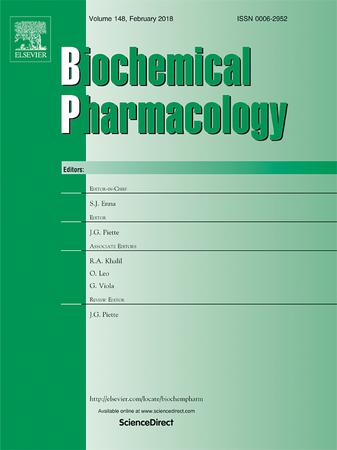Sphingosylphosphorylcholine induces itch via activation of TRPM3 and TRPA1 in mice
IF 5.3
2区 医学
Q1 PHARMACOLOGY & PHARMACY
引用次数: 0
Abstract
Itch is a prevalent symptom in atopic dermatitis (AD), often leading to a strong urge to scratch. Elevated levels of sphingosylphosphorylcholine (SPC) are found in the stratum corneum of AD patients, and while SPC is known to induce itch, its molecular targets are not well understood. This study aims to identify the signaling pathway of SPC-induced itch under AD conditions. We demonstrate that SPC specifically activates the Transient Receptor Potential Melastatin 3 (TRPM3) channel in sensory neurons. In HEK293T cells expressing TRPM3, SPC treatment caused a significant increase in intracellular calcium, which was inhibited by TRPM3 antagonists. Among various TRP channels tested, TRPM3 exhibited the highest reactivity to SPC, followed by TRPA1. Molecular docking analysis also supported interactions between SPC and both TRPM3 and TRPA1. In an AD mouse model, SPC-induced responses were dependent on TRPM3 and TRPA1, and the expression of these channels increased in dorsal root ganglion neurons. SPC-induced scratching behaviors were significantly reduced by TRPM3 and TRPA1 antagonists, with TRPM3 playing a critical role in spontaneous scratching. This study identifies TRPM3 and TRPA1 as key mediators of SPC-induced itch, providing potential therapeutic targets for treating itch in AD patients.

鞘甲磷胆碱通过激活小鼠TRPM3和TRPA1诱导瘙痒
瘙痒是特应性皮炎(AD)的普遍症状,经常导致强烈的抓挠冲动。在AD患者的角质层中发现鞘酰磷胆碱(SPC)水平升高,虽然SPC已知会引起瘙痒,但其分子靶点尚不清楚。本研究旨在明确AD条件下spc诱导瘙痒的信号通路。我们证明SPC特异性激活感觉神经元中的瞬时受体电位美拉他汀3 (TRPM3)通道。在表达TRPM3的HEK293T细胞中,SPC处理引起细胞内钙的显著增加,而这被TRPM3拮抗剂抑制。在测试的各种TRP通道中,TRPM3对SPC的反应性最高,其次是TRPA1。分子对接分析也支持了SPC与TRPM3和TRPA1之间的相互作用。在AD小鼠模型中,spc诱导的反应依赖于TRPM3和TRPA1,这些通道在背根神经节神经元中的表达增加。TRPM3和TRPA1拮抗剂显著降低了spc诱导的抓痕行为,其中TRPM3在自发抓痕中起关键作用。本研究发现TRPM3和TRPA1是spc诱导瘙痒的关键介质,为治疗AD患者瘙痒提供了潜在的治疗靶点。
本文章由计算机程序翻译,如有差异,请以英文原文为准。
求助全文
约1分钟内获得全文
求助全文
来源期刊

Biochemical pharmacology
医学-药学
CiteScore
10.30
自引率
1.70%
发文量
420
审稿时长
17 days
期刊介绍:
Biochemical Pharmacology publishes original research findings, Commentaries and review articles related to the elucidation of cellular and tissue function(s) at the biochemical and molecular levels, the modification of cellular phenotype(s) by genetic, transcriptional/translational or drug/compound-induced modifications, as well as the pharmacodynamics and pharmacokinetics of xenobiotics and drugs, the latter including both small molecules and biologics.
The journal''s target audience includes scientists engaged in the identification and study of the mechanisms of action of xenobiotics, biologics and drugs and in the drug discovery and development process.
All areas of cellular biology and cellular, tissue/organ and whole animal pharmacology fall within the scope of the journal. Drug classes covered include anti-infectives, anti-inflammatory agents, chemotherapeutics, cardiovascular, endocrinological, immunological, metabolic, neurological and psychiatric drugs, as well as research on drug metabolism and kinetics. While medicinal chemistry is a topic of complimentary interest, manuscripts in this area must contain sufficient biological data to characterize pharmacologically the compounds reported. Submissions describing work focused predominately on chemical synthesis and molecular modeling will not be considered for review.
While particular emphasis is placed on reporting the results of molecular and biochemical studies, research involving the use of tissue and animal models of human pathophysiology and toxicology is of interest to the extent that it helps define drug mechanisms of action, safety and efficacy.
 求助内容:
求助内容: 应助结果提醒方式:
应助结果提醒方式:


